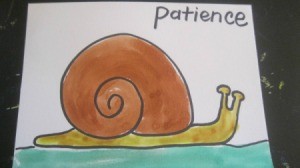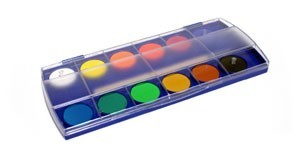 I recently learned of Etegami, a Japanese folk art. It's a simple hand-painted drawing accompanied by a few words. It's usually done on postcards and they are meant to be sent to someone. What I love about this style of art is that is not meant to be perfect. The paint can go out of the lines or not cover everything and that is the desired look. I taught this technique to a few middle school classes and the kids loved the project. It's so easy and fun. The kids really enjoyed making their creations.
I recently learned of Etegami, a Japanese folk art. It's a simple hand-painted drawing accompanied by a few words. It's usually done on postcards and they are meant to be sent to someone. What I love about this style of art is that is not meant to be perfect. The paint can go out of the lines or not cover everything and that is the desired look. I taught this technique to a few middle school classes and the kids loved the project. It's so easy and fun. The kids really enjoyed making their creations.
Total Time: Not very long to make a picture. But, we made lots!
Yield: to make!
Source: Japanese folk art
Supplies:
Steps:



This page contains the following solutions.
It is nice to use pretty smelling lotion in the place of water when painting with watercolors. This makes the colors more pastel and the final art looks really nice ;)
Here are the questions asked by community members. Read on to see the answers provided by the ThriftyFun community.
I am an artist. I need to know how salt causes the paint pigments to separate and cause a starburst effect?
Reen from Cherokee, NC
I taught my art students to sprinkle salt on still wet water color painting to make a cool texture. None of us cared how it worked. It was fun, and safe even for kindergarten.
The salt absorbs the paint around its immediate area.
The star burst effect of using salt results in the moisture being soaked up by the salt. I have used this effect on silk painting and water colour. If you use rock salt you get one effect, if you use normal table salt you get a finer effect you can also use epsom salts to create another type of effect.
I thank you for the responses. I am fully aware that this works - I have done it for many years - what I am looking for is the scientific explanation.
You can check out simple explanation here
brushstrokesbykc.blogspot.com/
Salt will mix into water. The fine particles spread evenly throughout the water. As the water evaporates, the mixture dries and becomes solid again. Salt forms into crystals as it dries. The crystals are shaped like cubes with flat sides that reflect light causing the sparkle.
Watercolor is pigment and optional binders suspended in water. The water is what moves the pigment around. When you sprinkle granules of salt onto the paper, it does two things: first the granule absorbs the water it touches, along with the pigment that is suspended in the water, which causes the light specks on the paper.
 Advice for keeping the paper flat when working with watercolors. Post your own tips here.
Advice for keeping the paper flat when working with watercolors. Post your own tips here.
By SL Edens
By Cyinda
By sundaeskies
By Robin
With lower grade paper, (lower weight per sheet), soaking (yes, sloppy wet soaking)of the paper works best. Soak the paper for a few minutes submerged in water, lay it out over a wooden board and stapled the paper every few inches around the sides, starting from the center edge of each page, then the corners, then in between those staples. Let the paper dry and wha-la! 'Stretched paper' that won't buckle on you and pool your paint where you don't want it. Practice makes perfect--let me know if this is helpful to you. :)
By Kerra
Use masking tape to create a "frame" around all four edges of your paper, taping it to your table, drawing board, or whatever you are painting on. If you are not using good watercolor paper (very expensive) just try using a little less water when you paint. Leave the painting taped down until it is dry.
Recreate the entire solar system with supplies you probably already have at home. It's a great way to decorate a child's room and learn about the planets.
Try this easier approach to creating beautiful watercolor paintings, using water soluble markers. This post explains the process used in watercolor painting using markers.
Watercolor pencils are an easy and effective way to add beautiful color gradations and shading to you artwork. This is a page about how to use watercolor pencils.